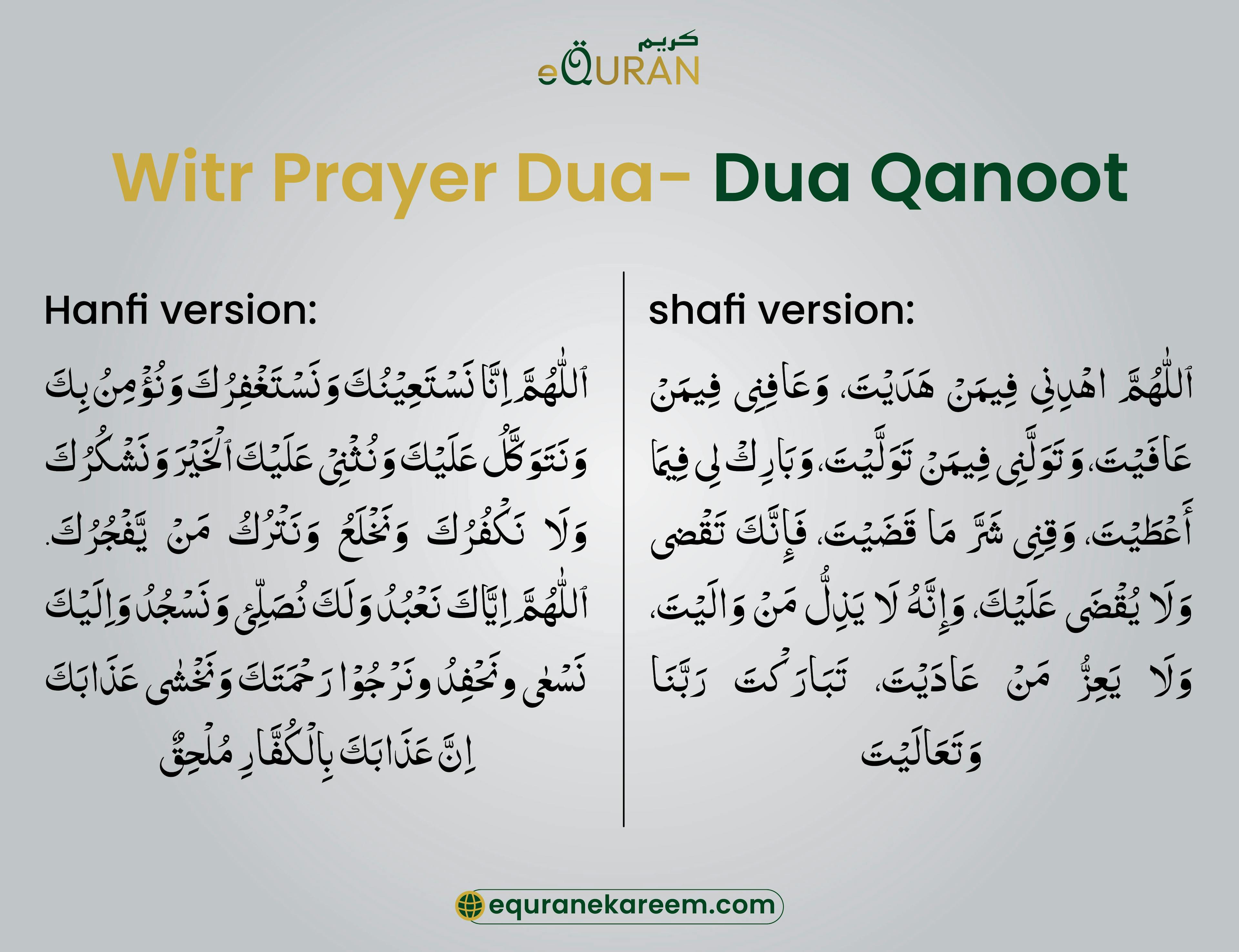
As the night deepens and the world grows quiet, there is a special prayer that the Prophet Muhammad (SAW) never abandoned, whether at home or traveling. It is known as the Witr prayer. But do you know when and how to offer Witr prayer?
In this blog, we will guide you on how to offer Witr with one and three Rakats.
What is Witr Prayer?
Witr means "odd" in Arabic. Witr is a prayer that is offered in an odd number of rakahs (units of prayer), such as one, three, five, seven, nine, and eleven. It is a highly recommended Sunnah prayer that concludes the night prayers, making it the last prayer before Fajr.
When to Pray Witr?
The time for the Witr prayer begins after the obligatory Isha prayer and lasts until the break of dawn, when Fajr prayer time begins. Hazart Abu Said al Khudri reported that the Prophet of Allah (SAW) said:
“Observe Witr prayer before it is morning.” (Sahih Muslim 754)
In another Hadith, Hazrat Ibn Umar(RA) narrates that Allah's Messenger (SAW) said:
"When Fajr begins, then every Salat of the night and Al-Witr have gone, so perform Al-Witr before Fajr begins." (At-Tirmidhi 469)
How to Offer Witr Prayer
There are differences of opinion regarding the method of offering Witr prayer. Primarily concerning the number of rak'ahs and the timing of reading the Dua e Qunoot. Some scholars (Hanafi School of thoughts) believe Witr can be prayed as three rakats with two tashahhuds and one tasleem. Other Scholars suggest performing it as two rakahs followed by a single rakah.
Hire an online tutor for your kids to learn the Quran and prayer from home.
The Hanafi Method of Offering Witr Prayer
The Hanafi school has a distinctive approach to the Witr prayer that sets it apart from other madhabs (schools of Islamic jurisprudence). This is considered wajib (obligatory) rather than just sunnah, giving it a higher status than in other schools.
The Hanafi school believes that Witr consists of three rakats performed continuously in one set, similar in structure to Maghrib prayer but with key differences.
Step-by-Step Method
First Two Rakats:
- Begin with the opening takbir and recite Surah al-Fatiha, followed by another surah in the first rakat
- After completing the first rakat, stand for the second
- Recite Fatiha and another surah in the second rakat
- Complete the second rakat and sit for tashahhud (at-tahiyyat)
- This sitting (jalsa) is a distinctive feature. You recite the full tashahhud as you recite while praying regular salah.
Third Rakat:
- Rise from the sitting position to perform the third rakat
- Recite Surah al-Fatiha, followed by another Surah
- After completing the recitation, say an additional takbir (Allahu Akbar) while standing
- Raise your hands briefly during this extra takbir
- Lower your hands and place them in the prayer position (right hand over left)
- Recite Dua al-Qunut
- After the Qunut, say "Allahu Akbar" and go into ruku
- Complete the ruku and sujud as normal
- Sit for the final tashahhud
- Complete with salutations (tasleem) to both sides
In this way, you completed your three rakat witr prayer.
Learn and memorize Quran online with our expert Quran tutors.
Praying Witr With Two Rak'ahs and One Separate Rak'ah
Witr prayer is also offered with two rakats and one separate rakat. This method is widely practiced by the Shafi, Maliki, and Hanbali schools of thought. It is supported by hadith that the Prophet (peace be upon him) said, "The Witr prayer is offered in units of 2 rak'ahs.”
Here's a detailed step-by-step guide for praying two rak'ahs with tasleem, followed by one separate rak'ah with tasleem:
First Two Rak'ahs
Rak'ah 1:
- Make your intention for Witr if you intend all three.
- Raise your hands and say the opening Takbir: "Allahu Akbar"
- Place your hands on your chest (right over left)
- Recite the "Subhanaka Allahumma"
- Recite Surah Al-Fatihah and recite another Surah or verses from the Qur'an.
- Say "Allahu Akbar" and bow into ruku'
- Say Subhana Rabbiyal Adheem in ruku - 3 times minimum
- Rise from ruku, saying "Sami' Allahu liman hamidah, Rabbana wa lakal hamd"
- Say "Allahu Akbar" and go into sujood (prostration)
- Say Subhana Rabbiyal A'la in sujood - 3 times minimum
- Say "Allahu Akbar" and sit up briefly
- Say "Allahu Akbar" and go into second sujood
- Say "Allahu Akbar" and stand up for the second rak'ah
Rak'ah 2:
- Recite Surah Al-Fatiha
- Recite another surah or verses
- Complete ruku' and sujood as in the first rak'ah
- Sit for Tashahhud after the second sujood
- Recite the complete Tashahhud (At-tahiyyatu lillahi...)
- Recite Salawat upon the Prophet (Allahumma salli 'ala Muhammad...)
- Make a brief dua
- Give tasleem to the right and left, saying "Assalamu alaikum wa rahmatullah"
Third Rak'ah (Witr)
- Make intention for the single rak'ah of Witr
- Say the opening Takbir: "Allahu Akbar"
- Place your hands on your chest
- Recite Surah Al-Fatiha, then recite another Surah
- Say "Allahu Akbar" and raise your hands for Qunut (supplication before ruku')
- Recite the Qunut dua (you can say: "Allahumma ihdini fiman hadayt..."
- Say "Allahu Akbar" and bow into ruku'
- Complete ruku' with glorifications
- Perform two sujood as usual
- Sit for the final Tashahhud
- Recite the complete Tashahhud and Salawat
- Make dua and give tasleem to the right and left
How to Pray 3 Rakat Witr in Isha
The time of Witr prayer starts after the Isha prayer and remains till the Fajr. Most muslims offer it soon after the Isha. Here is the guide on how to pray 3 rakat Witr in Isha.
Beginning the Prayer
Start by making your intention for Witr prayer. Raise your hands to your ears and say "Allahu Akbar," then fold your hands below your navel with the right hand over the left. Recite the opening supplication "Subhanaka Allahumma," then recite Surah Al-Fatihah. After Al-Fatiha, recite another surah or at least three short verses.
Completing the First Rak'ah
Say "Allahu Akbar" without raising your hands and bow into ruku', say "Subhana Rabbiyal Adheem" at least three times. Rise from ruku', saying "Sami' Allahu Liman Hamidah, Rabbana lakal hamd," then say "Allahu Akbar" and prostrate. In sujood, say "Subhana Rabbiyal A'la" three times. Sit up briefly with your left foot tucked under and right foot upright, say "Allahu Akbar," and perform the second prostration with the same glorifications. After completing the second sujood, say "Allahu Akbar" and stand up for the second rak'ah.
The Second Rak'ah
In the second rak'ah, say the Bismillah and recite Surah Fatiha, followed by another surah, preferably Surah Al-Kafirun. Complete the ruku' and both prostrations as before. After the second sujood, you must sit for Tashahhud. In this sitting, recite only the At-Tahiyyat portion without the Durood (Salawat upon the Prophet) and without giving tasleem. This sitting is what distinguishes the Hanafi Witr from other schools and makes it structurally similar to Maghrib prayer. After completing At-Tahiyyat, immediately say "Allahu Akbar" and stand up for the third rak'ah.
The Third Rak'ah with Qunut
Begin the third rak'ah by saying Bismillah, then recite Surah Al-Fatihah followed by another surah. Traditionally, Surah Al-Ikhlas is recited, though you may also add Surah Al-Falaq and An-Nas. After completing your recitation, this is when you perform the Qunut supplication. Say "Allahu Akbar" and raise your hands to your ears, then lower them below your navel. Recite the Dua al-Qunut, which begins with "Allahumma inna nasta'eenuka wa nastaghfiruka."
Concluding the Prayer
After completing the Qunut dua, say "Allahu Akbar" without raising your hands and bow into ruku'. Complete the ruku with its glorifications, rise up, and then perform both prostrations as usual. After the second prostration, sit for the final Tashahhud. This time, recite the complete At-Tahiyyat followed by Durood Shareef upon the Prophet (SAW), and then make any additional dua you wish. Finally, turn your head to the right, saying "Assalamu alaikum wa rahmatullah," then to the left with the same words, completing your Witr prayer.
How to Pray Witr Prayer After Tahajjud
If you plan to wake up for Tahajjud (night prayer), the Prophet (SAW) recommended praying Witr at the very end.
- Wake up in the last third of the night
- Pray as many rak'ahs of Tahajjud as you wish
- Pray Witr as your final prayer before Fajr
- This is considered the most virtuous time
The Prophet (SAW) said: "Make Witr your last prayer at night." (Sahih al-Bukhari 998)
Witr Prayer Dua- Dua Qanoot
The Witr prayer dua is known as Dua Qunoot. It is recited after the recitation of the Quran in the final rak'ah, typically before bowing (ruku). There are several authentic versions of Dua Qunoot, with the two most widely used being the "Shafi version" (focusing on personal guidance) and the "Hanafi version" (emphasizing communal supplication).

The Hanfi version of Witr prayer dua is:
ٱللَّٰهُمَّ اِنَّا نَسۡتَعِيۡنُكَ وَنَسۡتَغْفِرُكَ وَنُؤۡمِنُ بِكَ وَنَتَوَكَّلُ عَلَيۡكَ وَنُثۡنِىۡ عَلَيۡكَ ٱلۡخَيۡرَ وَنَشۡكُرُكَ وَلَا نَكۡفُرُكَ وَنَخۡلَعُ وَنَتۡرُكُ مَنۡ يَّفۡجُرُكَ. ٱللَّٰهُمَّ اِيَّاكَ نَعۡبُدُ وَلَكَ نُصَلِّئ وَنَسۡجُدُ وَاِلَيۡكَ نَسۡعٰى ونَحۡفِدُ ونَرۡجُوۡا رَحۡمَتَكَ وَنَخۡشٰى عَذَابَكَ اِنَّ عَذَابَكَ بِالۡكُفَّارِ مُلۡحِقٌٌ
The shafi version of Witr prayer dua is;
ٱللَّٰهُمَّ اهْدِنِي فِيمَنْ هَدَيْتَ، وَعَافِنِي فِيمَنْ عَافَيْتَ، وَتَوَلَّنِي فِيمَنْ تَوَلَّيْتَ، وَبَارِكْ لِي فِيمَا أَعْطَيْتَ، وَقِنِي شَرَّ مَا قَضَيْتَ، فَإِنَّكَ تَقْضي وَلَا يُقْضَى عَلَيْكَ، وَإِنَّهُ لَا يَذِلُّ مَنْ وَالَيْتَ، وَلَا يَعِزُّ مَنْ عَادَيْتَ، تَبَارَكْتَ رَبَّنَا وَتَعَالَيْتَ
Conclusion
Witr is a three-rak'ah prayer that is performed after Isha prayer. It can be prayed as 1, 3, 5, 7, or 9 rak'ahs, with the most common method being 3 rakats. It can be prayed in two main ways, either praying all three rak'ahs together with one final tashahhud or by praying two rak'ahs, giving the salam, and then praying a final single rak'ah.

Learn Quran Online With Us
Are you looking to learn the Quran with tajweed online, or want your kids to learn prayers and supplications? We are at your service. We have professional Quran and Islamic studies tutors to help you and your kids connect with Islam deeply.



